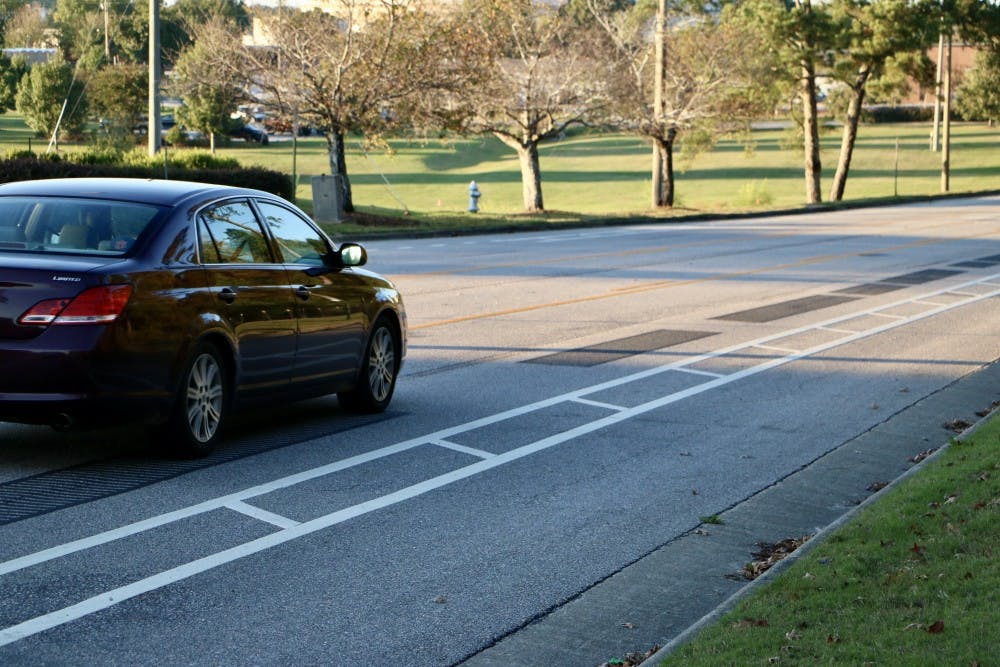One of the main features in Auburn football is the distant sound of the University's marching band performing “War Eagle” with every field goal and touchdown. The anthem has been exclusive to the band for decades, but now Auburn commuters have the chance to play it themselves on South Donahue Drive.
A temporary installation on the section of the road between Lem Morrison Drive and West Samford Avenue allows for vehicles that drive over it to play a low, rumbling version of the first verse of “War Eagle.”
The strip of song is a concept known as a “musical road,” and it was added to the street by Auburn University alumnus Tim Arnold in association with the University’s Samuel Ginn College of Engineering.
“I’d seen them before and was sort of fascinated by the science-meets-art aspect of it,” Arnold said. “President Jay Gogue had this idea ten years ago because he had heard about [other musical roads] unbeknownst to me when I started this out.”
Musical roads make use of rumble strips — the ridges on the edge of a road that alert drivers of danger — to produce a sound based on the vibration of vehicles. The original was created in Sweden as an art experiment.
“The science of sound is vibrations per second, or what they call kilohertz,” Arnold said. “We’ve all agreed upon that an A [note] is 440 kHz ... so we really kinda reverse engineered it.”
In “War Eagle,” the first note of the song is an F note, and a car needs to go over the road at 35 mph to travel over it for half a second and produce the right pitch and speed, he said.
“We made the traffic changes over the summer to reduce the speed limit on South Donahue, so this plays into helping those traffic calming measures,” said Benjamin Burmester, campus planner of the Office of the University Architect within Facilities Management. “That was one of our pieces in looking for the location.”
The project has been in the works for two years after Arnold took inspiration from other similar installations around the world. He was originally exposed to the concept after seeing one designed by Honda in 2008 in Lancaster, California, that plays “William Tell Overture.”
“They created it for a commercial, and I remember seeing that and thinking how remarkable it was that you could drive over these bumps mathematically laid out to hum the song,” he said. “At some point years ago, I was thinking Auburn should have one and, originally, I thought it should be on Exit 51 when you’re pulling into town [to say], ‘You’re here in Auburn, here’s the fight song.’”
Arnold also worked with the National Center for Asphalt Technology, which is based in Auburn, and Facilities Management to see the idea become a reality.
“We were approached by the College of Engineering, who asked if there was a place on campus [for a test run],” Burmester said.
The musical road was tested in May on the NCAT’s Test Track in Lee County in cooperation with director Randy West.
While musical roads of the last 20 years have been grooved cuts into the asphalt that are more permanent in their application, Burmester said Arnold's version virtually lies even on the road.
Burmester said it is a Department of Transportation approved surface application that isn't invasive on the actual road, which he said is more affordable.
Arnold did not disclose his methods or the cost of fabricating the surface application, but he set out to “build a better mousetrap," he said.
The first rendition of the Lancaster road suffered from miscalculations in notes, and local residents expressed frustration at the time about it being disruptive.
“We wanted to make something that nobody’s done before, so this surface application pavement marking tape is a game-changer,” he said. “The way we’ve engineered it is hopefully something innovative and new.”
Burmester estimates the material used for the strip should last up to six years and said it has been approved by the U.S. Department of Transportation for highways.
Texas A&M University features a similar art piece on its campus, which plays a verse from the “Aggie War Hymn,” but Arnold said it does not sound like his strip.
“Their fight song rumble strip that they have is purely percussive, it’s all monotone,” he said. “Ours really sings the fight song.”
Though he collaborated with various parties in each step of the project, Arnold supported the musical road’s design and development with his own funds, except for a roadside sign that the College of Engineering created.
He attributed the Department of Aerospace Engineering for its assistance in the manufacturing of the strip.
Arnold would like to bring more musical roads to Auburn with the positive reception the South Donahue strip has seen on social media. He already has his sights on his next project — a musical road which would play the namesake line from “Glory to Ole Auburn.”
“It’d be fun to have a scavenger hunt with different ones at different places around town,” he said. “The college model is a perfect place where culture, tradition and municipality meet. We’d love to do it in other places.”
As for now, Arnold said he’s pleased to bring the art piece to the college and the surrounding community.
“My wife works for the University, we live here," Arnold said. "This is the only place it was going to start."
The musical road will remain in place on South Donahue for the remainder of the fall football season, according to Burmester.
Do you like this story? The Plainsman doesn't accept money from tuition or student fees, and we don't charge a subscription fee. But you can donate to support The Plainsman.





